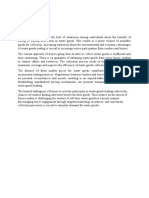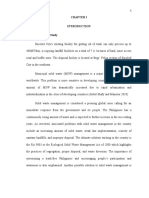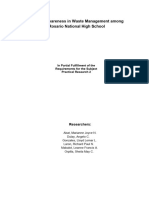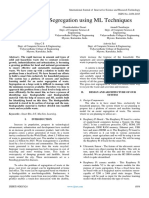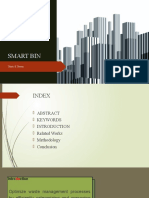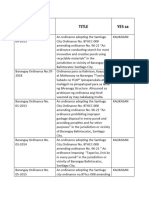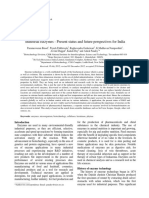Waste Segmentation Using Deep Learning
Waste Segmentation Using Deep Learning
Volume 8, Issue 11, November – 2023 International Journal of Innovative Science and Research Technology
ISSN No:-2456-2165
Waste Segmentation using Deep Learning
1
Anshdeep Singh Kapula, 2Esha Aishwarya, 3Shiva Pranav, 4Jattin Jaggi, 5Suresh A (Under the Guidance)
1,2,3,4
UG Students, 5Associate Professor
School of Computer Science and Engineering, Vellore Institute of Technology, Vellore
Abstract:- The inefficiencies in recycling bin Utilizing Deep Multiple Instance Learning and 3D
management have far-reaching consequences, primarily ResNets, a Python-backed system employs convolutional
manifesting as resource wastage and a deficiency in neural networks for real-time object recognition in Smart-
incident detection. Traditional recycling methods often BINs. Users earn rewards through an app for proper disposal
fall short in accurately separating and collecting as the automated bins sort waste accurately.
recyclable materials, resulting in valuable resources
ending up in landfills or being mishandled. However, the The following are some of the most prevalent issues
success of recycling initiatives doesn't rely solely on with conventional trash cans: Route optimization is
technological advancements. User education is a vital necessary, Bin saturation detection, preventing trash can 7
component in the quest to enhance global recycling rates. overflows, details of any strange incidents, Recycling
Raising public awareness about the importance of materials tainted, User distraction precision. Convention
recycling, the proper sorting of materials, and the centres, structures, stadiums, and transit hubs are using
significance of using dedicated recycling bins can cutting-edge solutions, such CleanRobotics TrashBotTM, a
significantly increase the efficacy of recycling efforts. smart container that collects high quality waste data and alerts
When people are well-informed and motivated to workers when it fills up. The AI technology in TrashBot is
participate, the impact on recycling rates is substantial. three times more precise at the disposal point than humans
Moreover, these methods lack the capacity to identify and traditional methods, whose accuracy is only 30%. Users'
and respond to critical incidents such as contamination, ambiguity when selecting whether things can and cannot be
spillage, or improper disposal. recycled makes it difficult to address the worldwide
challenge of increasing recycling rates. We cannot increase
One of the most remarkable benefits of AI in recycling rates or comprehend the kind of recycling system
recycling is its ability to divert recyclables away from required for a sustainable future without effective user
landfills. Through advanced sensors and machine education. AI technology has revolutionized recycling by
learning algorithms, AI can efficiently identify, separate, preventing recyclable materials (including metal, plastic,
and manage recyclable materialsin the waste stream. paper, glass, and more) from endingup in landfills.
In conclusion, addressing inefficient recycling bin The tech difficulties listed above can all be completed
management is of utmost importance to reduce resource by Smart-BIN. An automated garbage segregation and
wastage and improve incident detection. The integration management system based on the Internet of Things is our
of AI robotics, like CleanRobotics TrashBot™, is a invention. Specifically, this is a garbage collection and
transformative step towards achieving these goals, management container that can automatically collect and sort
significantly boosting waste collection accuracy. up various forms of waste, including paper, metal, glass,
However, alongside these technological advancements, organic waste, cloth, plastic, and e-waste. The rubbish that is
user education remains a cornerstone in the pursuit of placed in the bin is automatically separated.
enhancing global recycling rates. The combined efforts of
AI and informed individuals can indeed revolutionize Problem Statement
sustainability by preventing recyclables from ending up Effective waste management and segregation in India
in landfills and contributing to a more environmentally pose critical challenges that demand immediate attention.
responsible future. The country's rapid urbanization, population growth, and
changing consumption patterns have led to an alarming
I. INTRODUCTION increase in waste generation. However, the existing waste
management infrastructure is inadequate to cope with this
India faces a severe waste management challenge with escalating issue.
a significant gap between waste produced and properly
handled. Inadequate systems lead to landfill deposition. One facet of the problem is the lack of efficient waste
Redesigning waste management is vital. Lack of automation segregation practices at source. Households and businesses
and public- friendly systems contribute to street waste. AI often fail to segregate waste into biodegradable, non-
robotics show promise in improving recycling efficiency biodegradable, and hazardous categories, impeding proper
and incident detection. treatment and recycling. This results in significant
environmental degradation, as untreated waste infiltrates
landfills, contaminates soil and water, and releases harmful
greenhouse gases. The socioeconomic dimension cannot be
IJISRT23NOV1733 www.ijisrt.com 1296
Volume 8, Issue 11, November – 2023 International Journal of Innovative Science and Research Technology
ISSN No:-2456-2165
overlooked either. Informal waste pickers, who play a crucial between indigestible and edible waste. The idea also
role in recycling, face abysmal working conditions and health includes the architectural layout for a smart garbage can that
hazards due to improper waste segregation. Additionally, utilises many sensors and a CPU. The suggested approach
limited public awareness about the importance of waste uses Bluetooth and an IoT connection to track data. While
separation perpetuates the problem. Bluetooth helps with short-range data monitoring using an
Android application, IoT enables control of real-time data
Addressing these challenges necessitates multifaceted from any location. CNN implementation and training can be
interventions. Implementing comprehensive public difficult and time- consuming tasks that call for specific skills
awareness campaigns to educate citizens about waste and resources. The CNN's ability to gather and interpret data
segregation and recycling benefits is vital. Strengthening accurately may be impacted by the sensor accuracy
waste management infrastructure, establishing efficient employed in smart garbage cans. Due to Bluetooth's limited
collection and transportation systems, and facilitating the range, not all trash cans may be able to be monitored in real
formalization of the informal waste sector are imperative time
steps.
III. PRODUCT DESCRIPTION
II. LITERATURE SURVEY
A smart waste bin employing Convolutional Neural
Creation of a system model to forecast regional waste Networks (CNNs) for garbage classification and segregation
management planning performance and flow through 2023, is a groundbreaking innovation in waste management. This
Aidong Yang and Kok Siew Ng This paper suggests a technology incorporates advanced AI algorithms to
complete system model using stock-and-flow diagrams to automate the process of sorting different types of waste,
analyse the performance of the existing waste management enhancing efficiency and sustainability. Equipped with
system and anticipate future waste generation, treatment, integrated cameras and sensors, the smart bin captures
and disposal scenarios. The model, which shows the images of incoming waste items as they are disposed of.
generation and collection of household garbage, waste These images are then analyzed by a CNN, a deep learning
sewage treatment and disposal, and energy recovery, is architecture optimized for image recognition tasks. The
composed of three interconnected parts. Economic, CNN classifies the waste into categories such as organic,
environmental, and social variables are not taken into recyclable, and hazardous based on learned patterns from its
consideration by the model. The model may be further training data. Upon successful classification, the smart bin's
modified to study detailed environmental consequences internal mechanism opens the corresponding compartment
associated with waste management by adding nutrient fluxes designated for each waste type. The waste is then
at local and regional scales, as well as greenhouse gas automatically directed to the appropriate compartment,
emissions pollutants to land, water, and air. ensuring accurate segregation without human intervention.
This not only minimizes contamination and improves
Global knowledge base for managing solid waste in recycling rates but also reduces the workload on waste
cities: creation of frameworks and their use in forecasting management personnel.
trash generation through 2022, Rui He, Paulo Ferrao, Scott
Matthews, Ian Scott, Rui Semeano, Mexitli Sandoval Reyes, IV. OVERVIEW
and Mitchell J. Small. This project aims to gather and make
available the current MSW data environment by developing Capture Images/Video: The process begins with
a comprehensive framework for understanding the capturing images or video footage using cameras or sensors.
interconnectedness of various subdomains of MSW These cameras are typically positioned to monitor a specific
information. 1720 records of MSW generation, composition, area, such as the opening of a smart bin or a designated
management techniques for 219 nations and 410 localities region where objects are expected to appear. Detect Moving
were compiled after existing databases and governmental Object: The captured images or video frames are then
publications were examined. As a complex socio-technical analyzed in real- time to detect any moving objects. This
system, SWMS necessitates comprehensive design and detection can be achieved using computer vision techniques,
decision-making methods backed by a systemic perspective. which involve analyzing changes in pixel values between
As a result, it makes an effort to offer an extensive MSW consecutive frames. If a moving object is detected within the
knowledge base that indexes important data sources, reveals monitored area, the system proceeds to the next step. Object
connections between different MSW knowledge Classification: Once a moving object is detected, the system
subdomains, and fosters knowledge sharing. engages in object classification. This involves determining
the type or category of the object that has been detected.
Deep learning-based intelligent waste management Various machine learning algorithms, such as deep learning
system with Internet of Things - 2020, Mohammad Motiur models, can be used to classify objects based on their visual
Rahman, Md. Mahmodul Hasan, Arafat Hasan, Nasima features. The system compares the detected object's
Islam Bithi, Md. Wahidur Rahman, and Rahabul Islam. The characteristics with its database of known object types to
waste management system outlined in this paper can be identify it accurately. Open Corresponding Compartment:
implemented using deep learning and the Internet of Things. After the object is successfully classified, the system
The suggested solution uses convolutional neural networks accesses its internal database or logic to determine the
(CNN), a well-liked deep learning model, to discern appropriate action. In this case, the system identifies the
IJISRT23NOV1733 www.ijisrt.com 1297
Volume 8, Issue 11, November – 2023 International Journal of Innovative Science and Research Technology
ISSN No:-2456-2165
corresponding compartment in the smart bin that is solutions like the CleanRobotics TrashBotTM are being
designated for the detected object category. The system then employed. The TrashBot is a smart container designed to
triggers the mechanism to open the relevant compartment, efficiently gather high-quality waste data and notify
providing access for the user to place the object inside. personnel when it requires emptying. The TrashBot's AI
Object Disposal: Once the compartment is open, the user technology surpasses human and conventional methods by
can place the detected object inside it. This can be a manual achieving three times the accuracy at the disposal stage, as
action by a person or an automated process, depending on opposed to the mere 30% accuracy of traditional methods.
the design of the smart bin. The compartment might include
sensors to confirm that the object has been properly placed One of the global challenges in recycling is the
inside before proceeding. confusion among users when it comes to differentiating
between recyclable and non-recyclable items. To effectively
V. PROPOSED METHODOLOGY address the worldwide goal of increasing recycling rates, it
is imperative to overcome this ambiguity. The adoption of
A. Objectuve AI technology has brought about a transformation in the
The prevailing issues associated with traditional trash recycling industry by preventing recyclable materials such as
cans encompass several aspects. These include the need for metal, plastic, paper, glass, and more from ending up in
optimizing waste collection routes, detecting when bins are landfills.
reaching their capacity, preventing overflow situations,
documenting unusual incidents, ensuring the purity of As previously mentioned, the system being discussed
recycled materials, and enhancing user engagement and is an Internet of Things (IoT)-based automatic waste
accuracy. segregation, collection, and management system,
implemented in the form of an intelligent waste bin.
In various settings such as convention centers,
buildings, stadiums, and transportation hubs, advanced B. Workflow Diagram
Fig 1 Workflow Diagram
Fig 2 Feature Maps
IJISRT23NOV1733 www.ijisrt.com 1298
Volume 8, Issue 11, November – 2023 International Journal of Innovative Science and Research Technology
ISSN No:-2456-2165
A kernel component in the convolution layer of a CNN features.
performs convolution operations on the input image. In the
realm of image processing, kernels are analogous to filters. Many CNNs require a fixed input shape. When dealing
By giving back a feature map, it functions as a feature with images of various sizes, there are two options. The first
extractor. Convolution provides a number as its output, is to resize the image with distortion, which may result in
which shows whether the feature is present or not. The some loss of image content. The second option is to resize an
presence of the characteristic detected by the kernel is image by cropping and padding it, where some parts of the
indicated by a high numeric value. We can locate the image are lost, and others may be altered.
features in the image thanks to the feature map. The feature
maps are then resized and normalised using the subsampling D. Data Augmentation
layer. It generates an input matrix summary. Depending on Data augmentation is a technique that generates
the CNN algorithm type, the convolutional layer and multiple alternative images from a single photograph. This
subsampling layer (red block) are repeated several times. A method artificially expands the dataset, leading to improved
vector is created by concatenating the final feature maps. performance in machine learning models. Data augmentation
The input of the Multi-Layer Perceptron (MLP) completely enhances a model's ability to handle variations in images and
linked in the blue block and the output of the red block contributes to better generalization of kernels.
make up the vector. The input image is classified by the
MLP based on how each feature map corresponds to a Data augmentation encompasses various methods, such
certain class. as image translation, rotation, brightness and contrast
adjustments, zooming, and color perturbations.
Our innovative Smart Waste Segregation System
(SWSS) represents a significant leap forward in waste In scenarios where the dataset is imbalanced, with one
management technology. SWSS not only recognizes the class being more prevalent than another, adding more data
limitations of existing waste segregation models but also to the underrepresented classes can create a balanced
introduces novel improvements that overcome these dataset. In such cases, attributes like image background,
challenges. It employs a holistic approach, considering hue, or object orientation are not the defining features.
economic, environmental, and social factors in its decision- Instead, the focus is on object shape or texture, which are the
making process, thus promoting sustainable waste key characteristics that distinguish classes. To assist the
management practices. By integrating advanced statistical model in its classification, we can remove potentially
analysis and machine learning algorithms, SWSS enhances misleading features it might infer. By introducing image
data quality and prediction accuracy, allowing for more rotations and replacing color images with grayscale ones, we
informed waste management decisions. Furthermore, it guide the model in understanding what constitutes a feature
addresses issues such as shape and texture recognition, and what doesn't.
recognition accuracy at image edges, and disposal precision,
making it a comprehensive and efficient solution. With E. Transfer Learning
SWSS, we aim to revolutionize waste Transfer learning is a process that involves improving
the learning of a new task by leveraging knowledge acquired
C. Data Preprocessing from a related task. When applying transfer learning, a model
The CNN autonomously learns the distinguishing initially exhibits better performance, learns more rapidly, and
features in images that are characteristic of the output classes ultimately achieves a higher level of performance. This
it is trainedfor. approach involves initializing a new model with features
learned by a pre-trained model.
During the training phase of a machine learning model,
the learning process takes place, where each iteration of For example, we can use features learned by a model
training adjusts the model's parameters to improve its trained to distinguish between cats and dogs to kickstart the
performance. An optimizer, which is a technique based on training of a new model aimed at distinguishing between
gradient descent algorithms, is utilized in the update stage of tigers and wolves.
the training process.
One widely recognized dataset in the field of machine
The issue of vanishing/exploding gradients can lead to learning is ImageNet, which consists of nearly 14 million
a decrease in model performance, and one solution is to annotated images. ImageNet regularly hosts large-scale
normalize the data. Normalization techniques like Min-Max visual recognition competitions, focusing on a subset of 1000
normalization are favored because they confine values to the categories. TensorFlow provides the capability for transfer
range [0, 1] or [-1, 1]. A different strategy is the normalised learning from pre-trained models on the ImageNet 2012
standard deviation, in which the standard deviation is 1 and challenge. Although ImageNet contains 1000 categories,
the mean is 0 for each characteristic. only a few of them are relevant to our specific project, such
as bottles (beer, soda, wine, pill, strawberry, banana, and
Colour photographs can be converted to grayscale orange bottles), dishrag, pizza, cheeseburgers, and rubber.
images for use in image classification challenges where an Utilizing ImageNet transfer learning, the model can already
object's colour is not a key characteristic. This guarantees identify some bottles and trash during the initial learning
that the model doesn't depend on inaccurate color-based phase.
IJISRT23NOV1733 www.ijisrt.com 1299
Volume 8, Issue 11, November – 2023 International Journal of Innovative Science and Research Technology
ISSN No:-2456-2165
After the initial transfer learning, fine-tuning is an The waste bin in question consists of six individual
optional step. This typically involves keeping the transfer modular compartments, each with a hexagonal shape,
learning layers frozen and training only the final MLP designed for ergonomic waste disposal. These compartments
(Multi-Layer Perceptron). The training process does not are affixed to a shaft connected to a stepper motor. When a
update the frozen layers. Even by using a pre-trained MLP user disposes of waste, a sensing module is activated,
on top of a transfer learning model, good results can still be comprising a camera, ultrasonic, capacitive, inductive, and IR
achieved. Fine- tuning further enhances performance by sensors. These sensors employ a novel algorithm that
conducting additional training cycles and unfreezing the combines image recognition using artificial intelligence with
previously frozen layers. physical sensor data to determine the type of waste.
Subsequently, the system rotates the corresponding bin
F. Hyperparameter Optimization compartment's opening to receive the waste. After disposal,
Hyperparameters are external parameters that the bin offers the user a reward, which can be claimed in the
significantly influence the adjustment of internal parameters form of reward points based on the quantity and type of waste
in machine learning models. Common hyperparameters deposited. An array of ultrasonic sensors positioned above
include the learning rate, which controls the step size for each compartment measures the fill levels.
updating model parameters with gradient descent. The
momentum hyperparameter helps maintain the previous Users are provided with RFID cards that they can scan
momentum of gradient descent weights, aiding convergence. on the RFID reader located on the bin. The system then
The number of epochs represents the training iterations, and assesses the waste level and type contributed by the user and
the batch size determines the amount of training data per calculates the corresponding reward points. It retrieves the
epoch. Activation functions define neuron outputs, and user's name, the points earned from the online server-side
optimizers dictate the type of gradient descent used. The database, and updates the current points. Following this
choice of loss function depends on the problem, be it process, the GPRS module gathers the bin's location
classification or regression. information and data from the ultrasonic sensor, transmitting
it to the server.
Optimizing hyperparameters is vital for achieving
high- quality solutions, but testing all combinations can be The entire bin operates on solar panels and a
impractical due to the exponential growth in training tasks. rechargeable battery, with excess power being redirected to
An alternative approach involves iterative testing using the grid when generated in surplus. When a bin compartment
heuristic algorithms to identify a reasonably good set of is full, it transfers the waste into an underground vacuum tube
hyperparameters. These algorithms streamline the process, network, which conveys the waste to the appropriate waste
reducing training tasks. The selection of hyperparameter treatment facility via a citywide pipeline network.
values should be data-specific, and large-scale machine
learning platforms can expedite optimization by running Addressing the need for automating waste collection
concurrent training jobs on multiple hardware from households and industries is a significant part of the
solution. To tackle this challenge, we intend to implement a
In addition to the common hyperparameters, fine- system in which waste from households and industries is
tuning machine learning models can involve techniques like gathered through garbage chutes and transported to street-
learning rate scheduling, decision threshold adjustment, and level containers. These containers will initially separate the
ROC curve analysis in classification problems. Learning waste and reduce the size of large waste items to ensure they
rate schedules help manage the learning rate's changes fit into small pipes. These small pipes will be powered by a
during training. The choice of decision threshold can affect vacuum system to transport waste from all collection points
the trade- off between different types of classification to a central storage location. Utilizing IoT sensors, we will
mistakes, and the ROC curve assists in finding the ideal be able to monitor the waste generated by each household
threshold setting. The G-Mean metric balances false and industry. These pipes will incorporate self-cleaning
positives and true positives and plays a role in optimizing mechanisms and blockage removal systems to ensure
model performance, particularly for imbalanced complete automation.
classification tasks.
VII. RESULTS AND CONCLUSION
VI. ALGORITHM
Our waste segregation model, developed using deep
CNNs, or convolutional neural networks, are learning techniques, has shown promising performance,
commonly employed in image classification and achieving an overall accuracy of 90.45%. This metric
identification tasks. They consist of various layers, indicates the proportion of correctly classified instances out
including convolutional, pooling, and fully connected layers. of the total instances in our dataset.
The convolutional layer utilizes filters to extract features
from the input image, while the pooling layer downsizes the The precision of our model is measured at 88.1%.
image to reduce computational complexity before the final Precision represents the accuracy of positive predictions,
prediction is made by the fully connected layer. The network showcasing the model's ability to correctly identify true
learns the most suitable filters through gradient descent and positives while minimizing false positives. In the context of
backpropagation. waste segregation, this implies that the model correctly
IJISRT23NOV1733 www.ijisrt.com 1300
Volume 8, Issue 11, November – 2023 International Journal of Innovative Science and Research Technology
ISSN No:-2456-2165
identifies and separates the various waste categories with high [6]. Vishnu, S., Ramson, S. J., Senith, S.,
accuracy, limiting the instances of misclassification. Anagnostopoulos, T., Abu- Mahfouz, A.M., Fan, X., ...
& Kirubaraj, A. A. (2021). IoT-Enabled solid waste
The F1 score, which considers both precision and recall, managementin smart cities. Smart Cities, 4(3), 1004-
is calculated at 0.82. This metric conveys the balance 1017.
between precision and recall, providing an overall measure
of the model's accuracy while considering both false
positives and false negatives. A value of 0.82 indicates a
reasonably good balance between the precision and recall of
our waste segregation model.
Furthermore, our model demonstrates a recall of 0.85.
Recall measures the proportion of actual positives that were
correctly identified by the model. In the context of waste
segregation, this implies that the model effectively captures a
significant percentage of the waste materials that should be
classified within a specific category.
The high accuracy, coupled with balanced precision,
recall, and F1 score, signifies that our deep learning model for
waste segregation is performing well across various metrics.
These results suggest that the model reliably identifies and
segregates different waste categories, contributing to effective
waste management processes.
It's important to note that while our model shows
strong performance, continuous improvements and
refinements could be made to further enhance its capabilities
in accurately segregating waste materials, thereby
contributing to more efficient waste management systems.
REFERENCES
[1]. Ng, K. S., & Yang, A. (2023). Development of a
system model to predictflows and performance of
regional waste management planning: A case study of
England. Journal of Environmental Management, 325,
116585.
[2]. He, R., Sandoval-Reyes, M., Scott, I., Semeano, R.,
Ferrao, P., Matthews, S.,& Small, M. J. (2022). Global
knowledge base for municipal solid wastemanagement:
Framework development and application in waste
generationprediction. Journal of Cleaner Production,
377, 134501.
[3]. Peura, P., Voutilainen, O., & Kantola, J. (2022). From
garbage to product and service systems: A longitudinal
Finnish case study of waste management evolution.
Waste Management, 140, 143-153.
[4]. Puig, S., & Foukia, N. (2022, August). CleverTrash: an
IoT system for waste sorting with deep learning. In
2022 IEEE International Conferences on Internet of
Things (iThings) and IEEE Green Computing &
Communications (GreenCom) and IEEE Cyber,
Physical & Social Computing (CPSCom) and IEEE
Smart Data (SmartData) and IEEE Congress on
Cybermatics (Cybermatics) (pp. 1- 8). IEEE.
[5]. Kokoulin, A. N., & Tur, A. I. (2022, January).
Recyclable Waste Optical Sorting System Based on
Neural Networks Ensemble. In 2022 Conference of
Russian Young Researchers in Electrical and Electronic
Engineering (ElConRus)(pp. 345-348). IEEE.
IJISRT23NOV1733 www.ijisrt.com 1301
You might also like
- Development of Reverse Vending Machine RVM Framewo PDFNo ratings yetDevelopment of Reverse Vending Machine RVM Framewo PDF6 pages
- Mambajao National High School - Senior High SchoolNo ratings yetMambajao National High School - Senior High School41 pages
- Proposal To Install Auto-Sorting MachineNo ratings yetProposal To Install Auto-Sorting Machine9 pages
- Smart Waste Management System Using Iot: Related PapersNo ratings yetSmart Waste Management System Using Iot: Related Papers4 pages
- Automation of Waste Segregation System Using PLC100% (1)Automation of Waste Segregation System Using PLC4 pages
- Arduino Based Wastage Segregator For Efficient Waste ManagementNo ratings yetArduino Based Wastage Segregator For Efficient Waste Management3 pages
- Solar Powered Smart Compactor Trash Bin With Charging Station0% (1)Solar Powered Smart Compactor Trash Bin With Charging Station2 pages
- IOT Based Smart Garbage Bin Alert System Using HC SR04 Ultrasonic Sensor0% (1)IOT Based Smart Garbage Bin Alert System Using HC SR04 Ultrasonic Sensor4 pages
- Eco Friendly Environment by Managing Waste DisposalNo ratings yetEco Friendly Environment by Managing Waste Disposal3 pages
- Solid Waste Management Center With RevisionsNo ratings yetSolid Waste Management Center With Revisions46 pages
- Concept Note For Sindh Solid Waste Management BoardNo ratings yetConcept Note For Sindh Solid Waste Management Board5 pages
- Download Complete Waste Management and Resource Recycling in the Developing World Pardeep Singh PDF for All Chapters100% (7)Download Complete Waste Management and Resource Recycling in the Developing World Pardeep Singh PDF for All Chapters66 pages
- BE - A - GROUP 7 Synopsis Report (Automatic Waste Segregator)No ratings yetBE - A - GROUP 7 Synopsis Report (Automatic Waste Segregator)12 pages
- Assessing The Level of Awareness in Solid Waste Management Among The Grade 12 Students of Ave Maria CollegeNo ratings yetAssessing The Level of Awareness in Solid Waste Management Among The Grade 12 Students of Ave Maria College41 pages
- Waste Management and Recycling System With E - Money Rewarding SystemNo ratings yetWaste Management and Recycling System With E - Money Rewarding System6 pages
- Automatic Waste Segregation Using Image Processing and Machine Learning100% (4)Automatic Waste Segregation Using Image Processing and Machine Learning2 pages
- PR2Plastic To Purpose Rethinking Waste Management With Bottle Infused Trash BinsNo ratings yetPR2Plastic To Purpose Rethinking Waste Management With Bottle Infused Trash Bins29 pages
- Waste Classification Using Convolutional Neural Network On Edge DevicesNo ratings yetWaste Classification Using Convolutional Neural Network On Edge Devices5 pages
- Arduino Based Automatic Waste Segregation System: Name of GuideNo ratings yetArduino Based Automatic Waste Segregation System: Name of Guide10 pages
- Trash Items Found: Garbage Bin 1 Garbage Bin 2 Garbage Bin 3100% (1)Trash Items Found: Garbage Bin 1 Garbage Bin 2 Garbage Bin 34 pages
- Utilizing Instructional Games As An Innovative Tool To Improve Science Learning Among Elementary School StudentsNo ratings yetUtilizing Instructional Games As An Innovative Tool To Improve Science Learning Among Elementary School Students6 pages
- A Novel Design Algorithm For Multifunctional Drawing Table - JANUARY 2021No ratings yetA Novel Design Algorithm For Multifunctional Drawing Table - JANUARY 20216 pages
- Assessment of Knowledge, Attitude and Practice of Medical Staff Towards Medical Waste Management in Jinja Regional Referral Hospital in Jinja District Uganda100% (1)Assessment of Knowledge, Attitude and Practice of Medical Staff Towards Medical Waste Management in Jinja Regional Referral Hospital in Jinja District Uganda10 pages
- Smart Waste Segregation Using ML TechniquesNo ratings yetSmart Waste Segregation Using ML Techniques3 pages
- Suhaib A. Bandh (Editor), Fayaz A. Malla (Editor) - Waste Management in The Circular Economy-Springer (2024)No ratings yetSuhaib A. Bandh (Editor), Fayaz A. Malla (Editor) - Waste Management in The Circular Economy-Springer (2024)325 pages
- Environmental Issues Pancasilla If 47 INT William Azaria Simanjuntak 103012340356No ratings yetEnvironmental Issues Pancasilla If 47 INT William Azaria Simanjuntak 1030123403564 pages
- Epistemic Risks of Big Data Analytics in Scientific Discovery: Analysis of the Reliability and Biases of Inductive Reasoning in Large-Scale DatasetsNo ratings yetEpistemic Risks of Big Data Analytics in Scientific Discovery: Analysis of the Reliability and Biases of Inductive Reasoning in Large-Scale Datasets7 pages
- The Digital Influence ChatGPT and its Role in Shaping Youth Cognitive Processes and Decision-MakingNo ratings yetThe Digital Influence ChatGPT and its Role in Shaping Youth Cognitive Processes and Decision-Making5 pages
- To Compare the Effectiveness of Jacobson’s Relaxation Techniques and Mitchell’s Relaxation Techniques along with Diaphragmatic Breathing on Insomnia in Elderly IndividualsNo ratings yetTo Compare the Effectiveness of Jacobson’s Relaxation Techniques and Mitchell’s Relaxation Techniques along with Diaphragmatic Breathing on Insomnia in Elderly Individuals9 pages
- Influence of Age, Gender, Socioeconomic Status, and Education Level on Glycemic Control in Diabetic Patients Attending Kapkatet Sub-County Hospital, Kericho County, KenyaNo ratings yetInfluence of Age, Gender, Socioeconomic Status, and Education Level on Glycemic Control in Diabetic Patients Attending Kapkatet Sub-County Hospital, Kericho County, Kenya9 pages
- Bridging the Digital Divide in Agriculture: Lessons from the United States and Africa in Smart Farming AdoptionNo ratings yetBridging the Digital Divide in Agriculture: Lessons from the United States and Africa in Smart Farming Adoption10 pages
- A Comparative Analysis of Natural Language Processing Models: BERT and LSTM in Enhancing Business CommunicationNo ratings yetA Comparative Analysis of Natural Language Processing Models: BERT and LSTM in Enhancing Business Communication6 pages
- From Visualization to Purchase: How Augmented Reality (AR), Virtual Reality (VR) and Artificial Intelligence (AI) Influence Consumer Purchase Decisions in Housing Design DecisionsNo ratings yetFrom Visualization to Purchase: How Augmented Reality (AR), Virtual Reality (VR) and Artificial Intelligence (AI) Influence Consumer Purchase Decisions in Housing Design Decisions23 pages
- Case Study and Examination of Production Methods in a Steel Manufacturing FacilityNo ratings yetCase Study and Examination of Production Methods in a Steel Manufacturing Facility7 pages
- Impact of Storytelling and Emotional Branding on Consumer Purchase Behavior in Quick Service Restaurants and FMCGNo ratings yetImpact of Storytelling and Emotional Branding on Consumer Purchase Behavior in Quick Service Restaurants and FMCG15 pages
- Comparing the Effect of Ashoka Ointment and Herjet OintmentNo ratings yetComparing the Effect of Ashoka Ointment and Herjet Ointment5 pages
- AI-Driven Predictive Analytics for Syndromic Surveillance: Enhancing Early Detection of Emerging Infectious Diseases in the United StatesNo ratings yetAI-Driven Predictive Analytics for Syndromic Surveillance: Enhancing Early Detection of Emerging Infectious Diseases in the United States8 pages
- Geriatric Medication Management Using STOPP/START Criteria on Polypharmacy in a Multicentre Hospital: A Systematic ReviewNo ratings yetGeriatric Medication Management Using STOPP/START Criteria on Polypharmacy in a Multicentre Hospital: A Systematic Review6 pages
- Remarkable Spatial Influences behind Shaping the Bangla Dance: Performer and Audience PerspectivesNo ratings yetRemarkable Spatial Influences behind Shaping the Bangla Dance: Performer and Audience Perspectives8 pages
- Psychological Well-being among Tribal and Non-Tribal B.Ed. StudentsNo ratings yetPsychological Well-being among Tribal and Non-Tribal B.Ed. Students4 pages
- Affirmative Policy on Belis in Marriage Traditions at Family Institutions in the Abenaho District of PapuaNo ratings yetAffirmative Policy on Belis in Marriage Traditions at Family Institutions in the Abenaho District of Papua14 pages
- Synergizing Renewables with Power Grid: A Path towards Stability and SustainabilityNo ratings yetSynergizing Renewables with Power Grid: A Path towards Stability and Sustainability5 pages
- Library Personnel’s Career Development and Job Performance of the National UniversityNo ratings yetLibrary Personnel’s Career Development and Job Performance of the National University8 pages
- Autonomous Obstacle Avoiding and Pesticide Spraying Robot for Smart FarmingNo ratings yetAutonomous Obstacle Avoiding and Pesticide Spraying Robot for Smart Farming4 pages
- Factors Influencing the Organizational Performance of Hotel EstablishmentsNo ratings yetFactors Influencing the Organizational Performance of Hotel Establishments12 pages
- An Integrated Web Application for Campus Life: A Digital Solution for Learning and VotingNo ratings yetAn Integrated Web Application for Campus Life: A Digital Solution for Learning and Voting8 pages
- Structural Equation Modeling of Students’ Performance in Pre-Calculus: Basis for Intervention in Senior High School100% (1)Structural Equation Modeling of Students’ Performance in Pre-Calculus: Basis for Intervention in Senior High School12 pages
- Citizen Satisfaction with Electronic-Government Services: A Case Study of Huduma Centre MombasaNo ratings yetCitizen Satisfaction with Electronic-Government Services: A Case Study of Huduma Centre Mombasa13 pages
- Leveraging Digital Surveillance Technologies for Managing Border Porosity and Enhancing Revenue Collection in KenyaNo ratings yetLeveraging Digital Surveillance Technologies for Managing Border Porosity and Enhancing Revenue Collection in Kenya11 pages
- Leveraging Wi-Fi-Based Tracking for Enhanced Conference Management and Exhibitor ValueNo ratings yetLeveraging Wi-Fi-Based Tracking for Enhanced Conference Management and Exhibitor Value11 pages
- Precision, Prediction and Progress: A New Era in PharmacologyNo ratings yetPrecision, Prediction and Progress: A New Era in Pharmacology23 pages
- EMS Procedure-Environmental Aspects With TemplatesNo ratings yetEMS Procedure-Environmental Aspects With Templates11 pages
- Solid Waste Management in Malaysia-CompleteNo ratings yetSolid Waste Management in Malaysia-Complete2 pages
- Innovative Environmental Protection Technologies To Reduce Air Pollution From Cement Manufacturing Industry in LiberiaNo ratings yetInnovative Environmental Protection Technologies To Reduce Air Pollution From Cement Manufacturing Industry in Liberia19 pages
- Tunza Vol. 10.1: Sport and The Environment (English)No ratings yetTunza Vol. 10.1: Sport and The Environment (English)24 pages
- Annexure Iv FORM 1 For Seeking Clearance For Projects Attracting CRZ Notification (I) Basic Information Sr. No. Item DetailsNo ratings yetAnnexure Iv FORM 1 For Seeking Clearance For Projects Attracting CRZ Notification (I) Basic Information Sr. No. Item Details15 pages
- Chiemchaisri Et Al - 2010 - Recovery of Plastic Wastes From Dumpsite As Refuse-Derived Fuel and ItsNo ratings yetChiemchaisri Et Al - 2010 - Recovery of Plastic Wastes From Dumpsite As Refuse-Derived Fuel and Its6 pages
- Sovertrade ISCC EU(V2) SOP - ISCC Management System ProcedureNo ratings yetSovertrade ISCC EU(V2) SOP - ISCC Management System Procedure13 pages
- Ways To Keep The The Neighbourhood CleanNo ratings yetWays To Keep The The Neighbourhood Clean1 page
- MKV Fenne: Pit Navigator Control of Secondary Air Control atNo ratings yetMKV Fenne: Pit Navigator Control of Secondary Air Control at8 pages
- 2020 Annual Report: The Opportunity ProjectNo ratings yet2020 Annual Report: The Opportunity Project20 pages
- The CLT Handbook: CLT Structures - Facts and PlanningNo ratings yetThe CLT Handbook: CLT Structures - Facts and Planning188 pages
- Life Cycle Assessment of Hydrogen Production From Biomass Gasification. Evaluation of Different Spanish FeedstocksNo ratings yetLife Cycle Assessment of Hydrogen Production From Biomass Gasification. Evaluation of Different Spanish Feedstocks7 pages
- CITY ORDINANCE NO. 010-2008 Solid Waste Mngt.No ratings yetCITY ORDINANCE NO. 010-2008 Solid Waste Mngt.24 pages
- Study On Utilization of Fly Ash As A Replacement of Cement ProfessorNo ratings yetStudy On Utilization of Fly Ash As A Replacement of Cement Professor57 pages
- Industrial Enzymes - Present Status and Future Perspectives For IndiaNo ratings yetIndustrial Enzymes - Present Status and Future Perspectives For India16 pages
- (FREE PDF Sample) E-Waste Recycling and Management: Present Scenarios and Environmental Issues Anish Khan Ebooks100% (2)(FREE PDF Sample) E-Waste Recycling and Management: Present Scenarios and Environmental Issues Anish Khan Ebooks53 pages
- A Read The Questions Carefully. Encircle The Letter of The Correct AnswerNo ratings yetA Read The Questions Carefully. Encircle The Letter of The Correct Answer6 pages
- Development of Reverse Vending Machine RVM Framewo PDFDevelopment of Reverse Vending Machine RVM Framewo PDF
- Mambajao National High School - Senior High SchoolMambajao National High School - Senior High School
- Smart Waste Management System Using Iot: Related PapersSmart Waste Management System Using Iot: Related Papers
- Arduino Based Wastage Segregator For Efficient Waste ManagementArduino Based Wastage Segregator For Efficient Waste Management
- Solar Powered Smart Compactor Trash Bin With Charging StationSolar Powered Smart Compactor Trash Bin With Charging Station
- IOT Based Smart Garbage Bin Alert System Using HC SR04 Ultrasonic SensorIOT Based Smart Garbage Bin Alert System Using HC SR04 Ultrasonic Sensor
- Eco Friendly Environment by Managing Waste DisposalEco Friendly Environment by Managing Waste Disposal
- Concept Note For Sindh Solid Waste Management BoardConcept Note For Sindh Solid Waste Management Board
- Download Complete Waste Management and Resource Recycling in the Developing World Pardeep Singh PDF for All ChaptersDownload Complete Waste Management and Resource Recycling in the Developing World Pardeep Singh PDF for All Chapters
- BE - A - GROUP 7 Synopsis Report (Automatic Waste Segregator)BE - A - GROUP 7 Synopsis Report (Automatic Waste Segregator)
- Assessing The Level of Awareness in Solid Waste Management Among The Grade 12 Students of Ave Maria CollegeAssessing The Level of Awareness in Solid Waste Management Among The Grade 12 Students of Ave Maria College
- Waste Management and Recycling System With E - Money Rewarding SystemWaste Management and Recycling System With E - Money Rewarding System
- Automatic Waste Segregation Using Image Processing and Machine LearningAutomatic Waste Segregation Using Image Processing and Machine Learning
- PR2Plastic To Purpose Rethinking Waste Management With Bottle Infused Trash BinsPR2Plastic To Purpose Rethinking Waste Management With Bottle Infused Trash Bins
- Waste Classification Using Convolutional Neural Network On Edge DevicesWaste Classification Using Convolutional Neural Network On Edge Devices
- Arduino Based Automatic Waste Segregation System: Name of GuideArduino Based Automatic Waste Segregation System: Name of Guide
- Trash Items Found: Garbage Bin 1 Garbage Bin 2 Garbage Bin 3Trash Items Found: Garbage Bin 1 Garbage Bin 2 Garbage Bin 3
- Utilizing Instructional Games As An Innovative Tool To Improve Science Learning Among Elementary School StudentsUtilizing Instructional Games As An Innovative Tool To Improve Science Learning Among Elementary School Students
- A Novel Design Algorithm For Multifunctional Drawing Table - JANUARY 2021A Novel Design Algorithm For Multifunctional Drawing Table - JANUARY 2021
- Assessment of Knowledge, Attitude and Practice of Medical Staff Towards Medical Waste Management in Jinja Regional Referral Hospital in Jinja District UgandaAssessment of Knowledge, Attitude and Practice of Medical Staff Towards Medical Waste Management in Jinja Regional Referral Hospital in Jinja District Uganda
- Suhaib A. Bandh (Editor), Fayaz A. Malla (Editor) - Waste Management in The Circular Economy-Springer (2024)Suhaib A. Bandh (Editor), Fayaz A. Malla (Editor) - Waste Management in The Circular Economy-Springer (2024)
- Environmental Issues Pancasilla If 47 INT William Azaria Simanjuntak 103012340356Environmental Issues Pancasilla If 47 INT William Azaria Simanjuntak 103012340356
- Epistemic Risks of Big Data Analytics in Scientific Discovery: Analysis of the Reliability and Biases of Inductive Reasoning in Large-Scale DatasetsEpistemic Risks of Big Data Analytics in Scientific Discovery: Analysis of the Reliability and Biases of Inductive Reasoning in Large-Scale Datasets
- The Digital Influence ChatGPT and its Role in Shaping Youth Cognitive Processes and Decision-MakingThe Digital Influence ChatGPT and its Role in Shaping Youth Cognitive Processes and Decision-Making
- To Compare the Effectiveness of Jacobson’s Relaxation Techniques and Mitchell’s Relaxation Techniques along with Diaphragmatic Breathing on Insomnia in Elderly IndividualsTo Compare the Effectiveness of Jacobson’s Relaxation Techniques and Mitchell’s Relaxation Techniques along with Diaphragmatic Breathing on Insomnia in Elderly Individuals
- Influence of Age, Gender, Socioeconomic Status, and Education Level on Glycemic Control in Diabetic Patients Attending Kapkatet Sub-County Hospital, Kericho County, KenyaInfluence of Age, Gender, Socioeconomic Status, and Education Level on Glycemic Control in Diabetic Patients Attending Kapkatet Sub-County Hospital, Kericho County, Kenya
- Bridging the Digital Divide in Agriculture: Lessons from the United States and Africa in Smart Farming AdoptionBridging the Digital Divide in Agriculture: Lessons from the United States and Africa in Smart Farming Adoption
- A Comparative Analysis of Natural Language Processing Models: BERT and LSTM in Enhancing Business CommunicationA Comparative Analysis of Natural Language Processing Models: BERT and LSTM in Enhancing Business Communication
- From Visualization to Purchase: How Augmented Reality (AR), Virtual Reality (VR) and Artificial Intelligence (AI) Influence Consumer Purchase Decisions in Housing Design DecisionsFrom Visualization to Purchase: How Augmented Reality (AR), Virtual Reality (VR) and Artificial Intelligence (AI) Influence Consumer Purchase Decisions in Housing Design Decisions
- Case Study and Examination of Production Methods in a Steel Manufacturing FacilityCase Study and Examination of Production Methods in a Steel Manufacturing Facility
- Impact of Storytelling and Emotional Branding on Consumer Purchase Behavior in Quick Service Restaurants and FMCGImpact of Storytelling and Emotional Branding on Consumer Purchase Behavior in Quick Service Restaurants and FMCG
- Comparing the Effect of Ashoka Ointment and Herjet OintmentComparing the Effect of Ashoka Ointment and Herjet Ointment
- AI-Driven Predictive Analytics for Syndromic Surveillance: Enhancing Early Detection of Emerging Infectious Diseases in the United StatesAI-Driven Predictive Analytics for Syndromic Surveillance: Enhancing Early Detection of Emerging Infectious Diseases in the United States
- Geriatric Medication Management Using STOPP/START Criteria on Polypharmacy in a Multicentre Hospital: A Systematic ReviewGeriatric Medication Management Using STOPP/START Criteria on Polypharmacy in a Multicentre Hospital: A Systematic Review
- Remarkable Spatial Influences behind Shaping the Bangla Dance: Performer and Audience PerspectivesRemarkable Spatial Influences behind Shaping the Bangla Dance: Performer and Audience Perspectives
- Psychological Well-being among Tribal and Non-Tribal B.Ed. StudentsPsychological Well-being among Tribal and Non-Tribal B.Ed. Students
- Affirmative Policy on Belis in Marriage Traditions at Family Institutions in the Abenaho District of PapuaAffirmative Policy on Belis in Marriage Traditions at Family Institutions in the Abenaho District of Papua
- Synergizing Renewables with Power Grid: A Path towards Stability and SustainabilitySynergizing Renewables with Power Grid: A Path towards Stability and Sustainability
- Library Personnel’s Career Development and Job Performance of the National UniversityLibrary Personnel’s Career Development and Job Performance of the National University
- Autonomous Obstacle Avoiding and Pesticide Spraying Robot for Smart FarmingAutonomous Obstacle Avoiding and Pesticide Spraying Robot for Smart Farming
- Factors Influencing the Organizational Performance of Hotel EstablishmentsFactors Influencing the Organizational Performance of Hotel Establishments
- An Integrated Web Application for Campus Life: A Digital Solution for Learning and VotingAn Integrated Web Application for Campus Life: A Digital Solution for Learning and Voting
- Structural Equation Modeling of Students’ Performance in Pre-Calculus: Basis for Intervention in Senior High SchoolStructural Equation Modeling of Students’ Performance in Pre-Calculus: Basis for Intervention in Senior High School
- Citizen Satisfaction with Electronic-Government Services: A Case Study of Huduma Centre MombasaCitizen Satisfaction with Electronic-Government Services: A Case Study of Huduma Centre Mombasa
- Leveraging Digital Surveillance Technologies for Managing Border Porosity and Enhancing Revenue Collection in KenyaLeveraging Digital Surveillance Technologies for Managing Border Porosity and Enhancing Revenue Collection in Kenya
- Leveraging Wi-Fi-Based Tracking for Enhanced Conference Management and Exhibitor ValueLeveraging Wi-Fi-Based Tracking for Enhanced Conference Management and Exhibitor Value
- Precision, Prediction and Progress: A New Era in PharmacologyPrecision, Prediction and Progress: A New Era in Pharmacology
- EMS Procedure-Environmental Aspects With TemplatesEMS Procedure-Environmental Aspects With Templates
- Innovative Environmental Protection Technologies To Reduce Air Pollution From Cement Manufacturing Industry in LiberiaInnovative Environmental Protection Technologies To Reduce Air Pollution From Cement Manufacturing Industry in Liberia
- Tunza Vol. 10.1: Sport and The Environment (English)Tunza Vol. 10.1: Sport and The Environment (English)
- Annexure Iv FORM 1 For Seeking Clearance For Projects Attracting CRZ Notification (I) Basic Information Sr. No. Item DetailsAnnexure Iv FORM 1 For Seeking Clearance For Projects Attracting CRZ Notification (I) Basic Information Sr. No. Item Details
- Chiemchaisri Et Al - 2010 - Recovery of Plastic Wastes From Dumpsite As Refuse-Derived Fuel and ItsChiemchaisri Et Al - 2010 - Recovery of Plastic Wastes From Dumpsite As Refuse-Derived Fuel and Its
- Sovertrade ISCC EU(V2) SOP - ISCC Management System ProcedureSovertrade ISCC EU(V2) SOP - ISCC Management System Procedure
- MKV Fenne: Pit Navigator Control of Secondary Air Control atMKV Fenne: Pit Navigator Control of Secondary Air Control at
- The CLT Handbook: CLT Structures - Facts and PlanningThe CLT Handbook: CLT Structures - Facts and Planning
- Life Cycle Assessment of Hydrogen Production From Biomass Gasification. Evaluation of Different Spanish FeedstocksLife Cycle Assessment of Hydrogen Production From Biomass Gasification. Evaluation of Different Spanish Feedstocks
- Study On Utilization of Fly Ash As A Replacement of Cement ProfessorStudy On Utilization of Fly Ash As A Replacement of Cement Professor
- Industrial Enzymes - Present Status and Future Perspectives For IndiaIndustrial Enzymes - Present Status and Future Perspectives For India
- (FREE PDF Sample) E-Waste Recycling and Management: Present Scenarios and Environmental Issues Anish Khan Ebooks(FREE PDF Sample) E-Waste Recycling and Management: Present Scenarios and Environmental Issues Anish Khan Ebooks
- A Read The Questions Carefully. Encircle The Letter of The Correct AnswerA Read The Questions Carefully. Encircle The Letter of The Correct Answer



